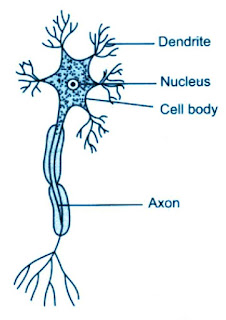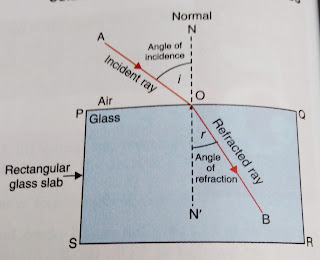Class 8 Science Solution : Light MCQ
Class 8 Science Solution: Multiple choice question of science related to NCERT book solution of CBSE class 8 student.
Question 1 : When a ray of incident light strikes the surface of a plane mirror at an angle of 60° with the mirror. The angle of reflection is:
(a) 30°
(b) 60°
(c) 45°
(d) none.
Answer: when a Ray of incident light strikes the surface of a plane mirror at an angle of 60°with the mirror then angle of reflection is also 60°.
You May Like
Question 1 : When a ray of incident light strikes the surface of a plane mirror at an angle of 60° with the mirror. The angle of reflection is:
(a) 30°
(b) 60°
(c) 45°
(d) none.
Answer: when a Ray of incident light strikes the surface of a plane mirror at an angle of 60°with the mirror then angle of reflection is also 60°.
You May Like
2. MCQ Questions for Class 8 Science with Answers Download PDF Solution Chapter Wise
3. MCQ Questions for Class 8 Science Chapter 6 Combustion and Flame with Answers
3. MCQ Questions for Class 8 Science Chapter 6 Combustion and Flame with Answers
2: When an object 40cm high is placed in front of a plane mirror at a distance of 100 cm then the size of the image will be.
(a) 20 cm (b) 40cm (c) 10cm (d) 100cm
Answer: when an object 40 cm high is placed in front of a plane mirror at a distance of 100 cm then the size of the image will be also 20 cm.
Question 3: Velocity of light in vacuum (air) is
(a)3×10^8cm/s
(b)3×10^8km/s
(c)3×10^8m/s
(d)none of these
Answer: the velocity of light in vacuum or air is 3 x 10^8m/s
Question 4: What will be the angle of reflection if angle of incidence is 0°?
(a) 90°
(b) 0°
(c)45°
(d)60°
Answer: when angle of incidence is 0°then angle of reflection is also 0°. (According to law of reflection)
Question 5: Lateral displacement produced by a glass slab is directly proportional to:
(a) Angle of incidence
(b) angle of refraction
(c) Thickness of the slab
(d) velocity of light
Answer: lateral displacement produced by a glass slab is directly proportional to its thickness of the slab.
Question 6: n×sinC=
(a) zero (b)1 (c)infinity (d) none of these
Answer: 1.
Question 7: To a fish, the plane surface of earth appears to be enclosed within an angle of
(a) 60°
(b)180°
(c)97°
(d)45°
Answer: 97°.
Question 8: Power of a lens is 2D, it’s focal length is
(a)-0.5 m (b)50 cm (c)150cm (d) 50m
Answer: when power of a lens is 2D, then its focal length is 50 cm.
Question 9: curvature of a plane glass is
(a)infinity (b)zero (c) eqal to C (d)none
Answer: curvature of a plane glass is infinity.
Question 10: Mayopia can be corrected using
(a) concave lens
(b)convex lens
(c) cylindrical lens
(d) Plano convex lens
Answers: myopia can be corrected using concave lens.
Question 11: A concave mirror is a part of a sphere of radius 20cm.It’s focal length is
(a) at infinity (b)10cm (c)15cm (d) 60cm
Answer: a concave mirror is a part of a sphere of radius 20 cm then its focal length is 10 cm.
Question 12: Magnification produced by a plane mirror is
(a)-1 (b) zero (c) +1 (d) infinity
Answer: magnification produced by a plane mirror is +1.
Question 13: Which type of mirror is used for focusing light ?
(a) Concave (b) Convex (c) plane (d) none
Answer: concave mirror is used for focusing light.
Question 14: When a ray of light is incident normally on the surface of a plane mirror, the angle of incidence is
(a) 90°
(b) 0°
(c) 45°
(d) none
Answer: 0°
Question 15: A stick in water appears broken due to
(a) reflection of light
(b) refraction of light
(c) total internal reflection
(d) none of these
Answer: ah stick in water appears broken due to refraction of light.
Question 16: Refractive index of diamond with respect to vacuum is 2.5, and then the velocity of light in diamond is.
(a) 25×10^8 m/s
(b)2.5×10^8 m/s
(c)1.2×10^8 m/s
(d)2.1×10^8m/s
Answer: 1.2 × 10^8 m/s
Question 17: A drop of water appears like pearl due to
(a)refraction of light
(b) none
(c)reflection of light
(d) total internal reflection of light
Answer: total internal reflection of light.
Question 18: When a concave mirror forms a real and enlarged image of an object ?
(a) when the object is placed at 2F
(b) when the object is placed at F
(c) when the object placed between F and C
(d) when the object placed between F and P
Answer: When the object placed between f and C of a concave mirror then it forms a real and enlarge image.
Question 19: What is the focal length of a plane mirror?
(a) zero
(b)infinity
(c) double of its aperture
(d)half of its aperture
Answer: the focal length of a plane mirror is zero.
Question 20: The splitting of light into its component colours is termed as
(a) refraction of light
(b)spectrum
(c) dispertion of light
(d) diffraction of light
Answer: splitting of light into its component is termed as Dispersion of light.
Question 21: If ‘i’ is critical angle, ‘r’ is
(a) zero
(b)90°
(c)180°
(d)45°
Answer: 90°.
Question 22: Sin C =
(a) n/1
(b) 1/n
(c) n2
(d)n/2
Answer: 1/n
Question 23: Critical angle of a substance is 30° then it’s refractive index is
(a)0.2 (b) 2 (c)0.5 (d)2.5
Answer: when critical angle of a substance is 30° then its refractive index is 2.
Question 24: Write the velocity of light in diamond.
(a)2.1×10^8 m/s
(b)1.2×10^8 m/s
(c)1.5×10^8 m/s
(d)2.5×10^8 m/s
Answer: the velocity of light in diamond is 1.2 × 10^8 m/s.
Question 25: What happens to the reflecting light when it travels from a optically rarer medium to the denser medium?
(a) goes straight
(b)bends away from normal
(c) bends towards normal
(d) reflect back
Answer: when a light travels from a optically denser medium to optically rarer medium, it will be nice to watch the normal.
(a) 20 cm (b) 40cm (c) 10cm (d) 100cm
Answer: when an object 40 cm high is placed in front of a plane mirror at a distance of 100 cm then the size of the image will be also 20 cm.
Question 3: Velocity of light in vacuum (air) is
(a)3×10^8cm/s
(b)3×10^8km/s
(c)3×10^8m/s
(d)none of these
Answer: the velocity of light in vacuum or air is 3 x 10^8m/s
Question 4: What will be the angle of reflection if angle of incidence is 0°?
(a) 90°
(b) 0°
(c)45°
(d)60°
Answer: when angle of incidence is 0°then angle of reflection is also 0°. (According to law of reflection)
Question 5: Lateral displacement produced by a glass slab is directly proportional to:
(a) Angle of incidence
(b) angle of refraction
(c) Thickness of the slab
(d) velocity of light
Answer: lateral displacement produced by a glass slab is directly proportional to its thickness of the slab.
Question 6: n×sinC=
(a) zero (b)1 (c)infinity (d) none of these
Answer: 1.
Question 7: To a fish, the plane surface of earth appears to be enclosed within an angle of
(a) 60°
(b)180°
(c)97°
(d)45°
Answer: 97°.
Question 8: Power of a lens is 2D, it’s focal length is
(a)-0.5 m (b)50 cm (c)150cm (d) 50m
Answer: when power of a lens is 2D, then its focal length is 50 cm.
Question 9: curvature of a plane glass is
(a)infinity (b)zero (c) eqal to C (d)none
Answer: curvature of a plane glass is infinity.
Question 10: Mayopia can be corrected using
(a) concave lens
(b)convex lens
(c) cylindrical lens
(d) Plano convex lens
Answers: myopia can be corrected using concave lens.
Question 11: A concave mirror is a part of a sphere of radius 20cm.It’s focal length is
(a) at infinity (b)10cm (c)15cm (d) 60cm
Answer: a concave mirror is a part of a sphere of radius 20 cm then its focal length is 10 cm.
Question 12: Magnification produced by a plane mirror is
(a)-1 (b) zero (c) +1 (d) infinity
Answer: magnification produced by a plane mirror is +1.
Question 13: Which type of mirror is used for focusing light ?
(a) Concave (b) Convex (c) plane (d) none
Answer: concave mirror is used for focusing light.
Question 14: When a ray of light is incident normally on the surface of a plane mirror, the angle of incidence is
(a) 90°
(b) 0°
(c) 45°
(d) none
Answer: 0°
Question 15: A stick in water appears broken due to
(a) reflection of light
(b) refraction of light
(c) total internal reflection
(d) none of these
Answer: ah stick in water appears broken due to refraction of light.
Question 16: Refractive index of diamond with respect to vacuum is 2.5, and then the velocity of light in diamond is.
(a) 25×10^8 m/s
(b)2.5×10^8 m/s
(c)1.2×10^8 m/s
(d)2.1×10^8m/s
Answer: 1.2 × 10^8 m/s
Question 17: A drop of water appears like pearl due to
(a)refraction of light
(b) none
(c)reflection of light
(d) total internal reflection of light
Answer: total internal reflection of light.
Question 18: When a concave mirror forms a real and enlarged image of an object ?
(a) when the object is placed at 2F
(b) when the object is placed at F
(c) when the object placed between F and C
(d) when the object placed between F and P
Answer: When the object placed between f and C of a concave mirror then it forms a real and enlarge image.
Question 19: What is the focal length of a plane mirror?
(a) zero
(b)infinity
(c) double of its aperture
(d)half of its aperture
Answer: the focal length of a plane mirror is zero.
Question 20: The splitting of light into its component colours is termed as
(a) refraction of light
(b)spectrum
(c) dispertion of light
(d) diffraction of light
Answer: splitting of light into its component is termed as Dispersion of light.
Question 21: If ‘i’ is critical angle, ‘r’ is
(a) zero
(b)90°
(c)180°
(d)45°
Answer: 90°.
Question 22: Sin C =
(a) n/1
(b) 1/n
(c) n2
(d)n/2
Answer: 1/n
Question 23: Critical angle of a substance is 30° then it’s refractive index is
(a)0.2 (b) 2 (c)0.5 (d)2.5
Answer: when critical angle of a substance is 30° then its refractive index is 2.
Question 24: Write the velocity of light in diamond.
(a)2.1×10^8 m/s
(b)1.2×10^8 m/s
(c)1.5×10^8 m/s
(d)2.5×10^8 m/s
Answer: the velocity of light in diamond is 1.2 × 10^8 m/s.
Question 25: What happens to the reflecting light when it travels from a optically rarer medium to the denser medium?
(a) goes straight
(b)bends away from normal
(c) bends towards normal
(d) reflect back
Answer: when a light travels from a optically denser medium to optically rarer medium, it will be nice to watch the normal.

